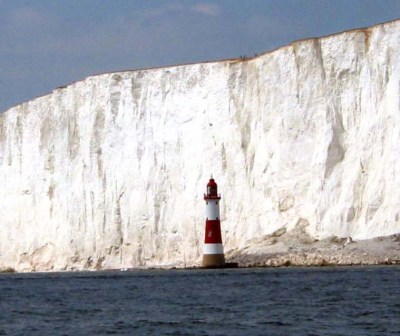

Beachy Head is a chalk headland on the south coast of England, close to the town of Eastbourne in the county of East Sussex. The cliff there is the highest chalk sea cliff in Britain, rising to 162 m (530 ft) above sea level. The peak allows views of the south east coast from Dungeness to the east, to Selsey Bill in the west. Its height has also made it a notorious suicide spot.
The chalk was formed in the Cretaceous period when the area was under the sea, 65 million years ago and earlier. During the Cenozoic Era the chalk was uplifted, and was later eroded to form the dramatic cliffs of the Sussex coast.
Some of the cliffs were lost in 2001 when, after a winter of heavy rains, a chalk pinnacle known as the Devil's Chimney, collapsed into the sea.
The name Beachy Head appears as 'Beauchef' in 1274, and was Beaucheif in 1317, becoming consistently Beachy Head by 1724, and has nothing to do with beach. Instead it is a corruption of the original French words meaning Beautiful Headland.[1]
The prominence of Beachy Head has made it a landmark for sailors in the English Channel. It is noted as such in the sea shanty "Spanish Ladies" :
The first land we sighted was called the Dodman,
Next Rame Head off Plymouth, off Portsmouth the Wight;
We sailed by Beachy, by Fairlight and Dover,
And then we bore up for the South Foreland light.
Contents [hide]
1 Lighthouses
2 Beachy Head at war
3 Tourism
4 Suicide
5 In Popular Culture
6 References
7 Images of Beachy Head
8 External links
[edit] Lighthouses
The headland was also a danger to shipping. In 1831 the construction of Belle
Tout lighthouse was started on the next headland west from Beachy Head, but
it did not become operational until 1834. Because its light could not be seen
in mist and low cloud, it was superseded by a newer lighthouse, 43m in height,
built in the sea below Beachy Head and operational from October 1902.[1] Until
the lighthouse was fully automated in 1983, the red and white striped tower
was manned by three lighthouse keepers. Their job was to maintain the light
that rotated two white flashes every 20 seconds, 26 miles out to sea. Belle
Tout lighthouse was moved more than 17 m (50 ft) further inland in March 1999
due to cliff erosion.[2]
[edit] Beachy Head at war
The third day of fighting in the Battle of Portland, 1653, took place off Beachy
Head during the First Anglo-Dutch War. The Battle of Beachy Head, 1690, was
a naval engagement during the Nine Years' War. During World War II, the RAF
established a forward relay station at Beachy Head to improve radio communications
with aircraft. In 1942, signals were picked up at Beachy Head which were identified
as TV transmissions from the Eiffel Tower. The Germans had reactivated the pre-war
TV transmitter and instituted a Franco-German service for military hospitals
and VIPs in the Paris region. The RAF monitored these programmes hoping (in
vain) to gather intelligence from newsreels.[3] There was also an important
wartime radar station in the area and, during the Cold War, a radar control
centre was operational in an underground bunker from 1953 to 1957.[1]
[edit] Tourism
West from Belle Tout, the cliffs drop down to Birling Gap, and beyond that the
Seven Sisters. The whole area is a popular tourist attraction, and Birling Gap
has a restaurant and, in the summer, multiple ice cream vans.
[edit] Suicide
Since the 1600s Beachy Head has been notorious as a location for people to attempt
suicide, estimated at 20 each year.[4] There are regular day and evening patrols
by the Beachy Head Chaplaincy Team, and a special telephone box with a direct
line to The Samaritans. After a steady increase in deaths between 2002 and 2005,
there was a marked decrease in 2006 with only seven fatalities, a reduction
attributed by the Maritime and Coastguard Agency to the actions of the Chaplaincy
Team and local media[5].
[edit] In Popular Culture
Beachy Head is also famous in film. In the 1979 film Quadrophenia, the character
Jimmy intends to ride off the chalk cliff top on a Vespa belonging to a gang
leader known as ‘Ace Face’. However, this results only in the scooter
colliding with the rocks at the base of the cliff.